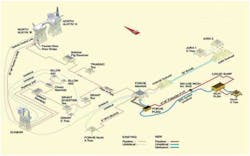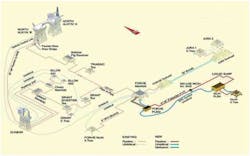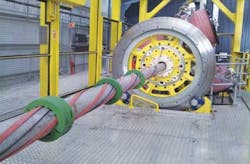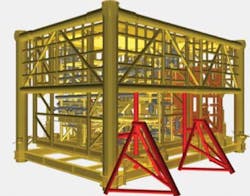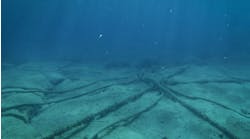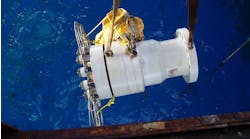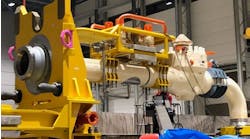Jean-Francois Cam
Total E&P UK
Flow assurance constraints imposed by existing subsea or topside infrastructure are among the main challenges of developing marginal fields in a mature offshore area.
In the case of Total E&P UK's (TEP UK) Islay field development in the UK North Sea – a 6-km (3.7-mi) subsea tieback to the company's Forvie subsea hub – the major challenge was responding to the likelihood of early formation water production. The chosen solution has been designed to achieve the most efficient passive insulation of the flowline while inhibiting hydrate formation, optimized by an innovative large-scale conditioning of the seabed.
Due to the reservoir's high pressure (620 barg) and the pressure rating of the existing network (520 barg), TEP UK also decided to incorporate a subsea high integrity pipeline protection system (HIPPS) into the new pipeline end manifold (PLEM), capitalizing on the company's experience with the Jura field subsea tieback in 2008. Inclusion of the HIPPS, in addition to the subsea heat exchanger ("cooling" loop) and fluid monitoring devices, made the PLEM one of the largest and most complex subsea structures in the world for a single well tieback.
Moreover, in a first for the Total Group, TEP UK selected a new TCP/IP (transmission control protocol/internet protocol) "open architecture" for the subsea control arrangement, articulated via fiber optic and power vehicles using subsea router modules (SRMs).
Finally, the company implemented a promising new technology for hydrate management: the world's first subsea electrically trace-heated pipe-in-pipe (ETH-PiP) system, along with the application of a subsea fiber optic temperature monitoring system.
Hydrate strategy
Analysis of the 2008 Islay discovery, while confirming reserves of 17 MMboe, also predicted an early water breakthrough after just one year of production. This, combined with the limited hydrate inhibitor injection capabilities of TEP UK's existing Alwyn and Dunbar platforms (which process output from the company's various subsea tiebacks), demanded an innovative strategy to unlock the development.
Although existing technologies for passive thermal insulation provided sufficient thermal inertia to prevent hydrate formation in most of the production scenarios (normal production and short shutdowns), the challenge for Islay was to avoid hydrate formation in shutdowns longer than 24 hours.
After a survey of the optimized flowline route, five separate depressions were identified – each capable of creating a liquid trap ideal for hydrate formation if fluids cooled to below 20°C (68°F). Inhibiting the water contained in these low points would have required additional methanol injection capacity on the Dunbar platform, which was incompatible with the existing infrastructure. TEP UK therefore decided instead to reshape the seabed along the pipeline route so that it had only three low points: one mid-route and one at each end of the flowline.
This work was carried out in October 2010 by Jan de Nul, a subcontractor of Technip UK – the main EPCI contractor for the Islay project. The 263-m (863-ft) longCristobal Colon, the world's largest suction hopper dredger, performed the dredging on two discrete areas along the flowline route – achieving the target seabed profile with vertical tolerances of less than 300 mm (11.8-in.). Although seabed conditioning had been done for "glory holes" in Canada's Grand Banks, this was the first time dredging had ever had been undertaken to this degree of accuracy or at such water depths (110 m/361 ft) – an impressive achievement in view of the dredging tool's 70-metric ton (77-ton) and 9-m (29-ft) wide suction head.
Also, the design of a midline injection point on the pipe-in-pipe system that includes the trace heating system in the pipe annulus was a challenge for Total and Technip. Technip proposed an innovative solution to include an injection tee midway along the flowline. This maintained reelability and integrity of the heating cables. To avoid damage of the tee branch, it was decided to perform the injection port drilling (patent pending) on a reeled bulkhead and then weld the tee branch offshore, onboard the Technip pipelay vesselApache II. The development of this solution resulted from Technip's long established R&D programs on reeling and patented reeled bulkhead technology. Project specific work included extensive full--scale trials for drilling and welding, and analysis involving computational fluid dynamics (CFD) and structural calculation.
Subsea module
In addition to the innovative hydrate management approach, and to ensure safe production of the high pressure/high temperature (HP/HT) reservoir – 620 barg and 120°C (248°F) – the design of the PLEM had to be developed specifically for the project.
The PLEM's first key function was to ensure that gas arriving at the existing Forvie network, 6 km west of the Islay christmas tree, would not exceed the 520-bar (7,542-psi) design rating of the existing infrastructure. TEP UK and partners Technip and Dril-Quip – capitalizing on the successful experience on the Jura field – decided to include in the PLEM a retrievable subsea HIPPS module with its own independent subsea control module (SCM). The latter comprised a dual redundant valve arrangement with multiple pressure sensors, with dimensions of 4x4x5 m (13x13x16.4 ft), and a weight of almost 40 mt (44 t). By incorporating a suitable level of redundancy in the components and using a safety integrity level (SIL) 4 logic solver, the required SIL 3 hardware capability was achieved. In addition, TEP UK decided to implement an architecture that would permit full testing and maintenance of the system remotely from the host platform.
The second key function was to ensure that gas from Islay would be produced within the operating temperature range of the existing network. To cope with the reservoir's 120°C (248°F) temperature, TEP UK chose to include in the PLEM a subsea heat exchanger ("cooling" loop) that would allow the fluid to be cooled by seawater, which at this depth was below 10°C (50°F). This component comprises a 76-m (249-ft) long 8-in. (20.3-cm) uninsulated piping loop, which can be bypassed for specific operating circumstances or in late field life.
In addition, the PLEM included other key features required for the safe and optimum production of the Islay reservoir, such as: start up and production chokes, multiphase flowmeter, multiple pressure and temperature sensors, sand detector, erosion probe, and numerous isolation valves to permit future intervention.
Other design parameters of the PLEM included:
- Ensure adequate inclination on the piping to allow free draining of the liquid to low points where methanol could be injected for hydrate prevention
- Select material suitable for HP/HT fluids, mainly super duplex
- Provide an over-trawlable structure for protection from fishing activities
- Provide an easily maintainable system with key sensitive components retrievable, either by ROV or divers.
This resulted in a structure with overall dimensions of 16x10x10 m (52x33x33 ft) and a gross weight of 340 mt (375 t), installed mainly by Technip's DSVSkandi Arctic.
Control system design
The Islay controls system consists of a dual-redundant fiber optic (FO) 100-Mb TCP/IP communication network architecture, with no copper communication redundancy incorporated. This will be the first system of this type onstream for Total, and reflects the group's latest specification.
A central distribution hub for the FO communications and 480 V electrical distribution systems was implemented at the Forvie PLEM. This comprises specially designed subsea router modules, each capable of providing up to seven switchable electrical and FO communications outputs. This also enables the existing Forvie manifold SCM to be retrofitted with the latest FO open communication architecture if required. Expansion slots are also provided for the hydraulic and chemical services for future tie-ins both here and at the Islay PLEM.
The Islay PLEM is serviced by a super duplex electro-hydraulic umbilical, which notably contains dual redundant fiber optic cables and a 2-in. 690 barg methanol line, along with a break out box to the methanol midline injection point, in addition to the standard services.
The subsea control module, situated on the Islay PLEM, has 30 hydraulic functions and contains dual FO subsea electronic modules. These interface with all standard pressure and temperature instrumentation, both on the PLEM and the christmas tree. Also included is the latest generation multiphase flowmeter and chemical injection metering valve, in addition to erosion and sand monitoring sensors.
Pipe-in-pipe trace heating
Hydrate mitigation is ensured by localized injection of methanol and "passive" insulation material in the annulus between the 6-in. (15.2-cm) super duplex flowline and the 12-in. (30.5-cm) outer carrier pipe. Oner feature of the Islay project stands out as potentially the most significant for the wider subsea oil and gas industry: the first ever use subsea of electrically trace-heated pipe-in-pipe (ETH-PiP).
In the technological battle against the new challenges of flow assurance, the trace heating of pipe promises power efficiency up to ten times greater than existing technologies, such as direct electrical heating or hot water circulation.
Over the past decade, anticipating the industry's interest, Technip has performed extensive R&D on ETH-PiP and joined Total's qualification program in 2008. After more than two years of successful qualification tests, Total considered the technology mature enough to allow the launch of a full-scale pilot, with Islay being selected due to its optimum size, the timing of the project, and the fact that hydrate mitigation was assured by the seabed conditioning approach.
Islay's ETH-PiP system, which relies on a multiple helix of conductive traces coiled around the inner pipe-in-pipe flowline, is effectively four heating elements wrapped along the length of the inner pipe. During the project phase, Technip developed a completely new cable application machine capable of winding four cables and two fiber optic lines in a helix around the internal production flowline, with each heat trace cable able to provide the required amount of energy independently. This machine was built into the spoolbase production line at Evanton, northern Scotland, in summer 2011.
In view of the future tests anticipated in this full-scale laboratory, TEP UK also decided to implement the best tool for monitoring the system's performance – the fiber optic temperature monitoring system, distributed temperature sensing.
The industrialization process undertaken during the project was the last opportunity to overcome remaining challenges of the new heat tracing technology, including:
- Finalizing the material selection: cables, insulation material, centralizer design
- Ensuring integrity of the dry annulus, while providing an outlet for the cables to hook up to the power source
- Ensuring the reliability of the various splices of cables required by the process (PiP stalk assembly or repairs)
- Minimizing the impact on the production rate of the PiP.
After 18 months' work, the ETH-PiP was successfully fabricated, tested, and spooled ontoApache II ready for subsea installation.
Development of the Islay field is nearing its successful conclusion, with first production expected in the first half of 2012.
Offshore Articles Archives
View Oil and Gas Articles on PennEnergy.com
